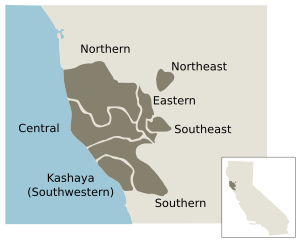Southern Pomo language facts for kids
Quick facts for kids Southern Pomo |
||||
|---|---|---|---|---|
| Native to | United States | |||
| Region | Northern California | |||
| Native speakers | 0 (2020) | |||
| Language family |
Pomoan
|
|||

The seven Pomoan languages with an indication of their pre-contact distribution within California
|
||||
|
||||
Southern Pomo is one of seven special languages spoken by the Pomo people. They live in Northern California near the Russian River and Clear Lake. These Pomo languages are all a bit different from each other. Southern Pomo is unique because it kept many old words from the original Pomo language. Sadly, very few people speak Southern Pomo today.
Contents
Who Spoke Southern Pomo?
The people who spoke Southern Pomo were not one big group. Instead, they lived in many different villages. Each village had its own slightly different way of speaking the language. The speakers did not have a special name for their language or themselves.
Because they lived in the southernmost area, they were the first to meet Spanish explorers. Later, they faced challenges when the United States took control of California. Many Southern Pomo speakers were forced to help build the last Spanish missions. These changes caused a great loss of speakers. Only the groups living further north, near Dry Creek and Cloverdale, continued to speak the language. This allowed language experts to study it later on.
Today, some Indian reservations, called rancherias in California, have members whose families spoke Southern Pomo. These include Dry Creek, Cloverdale, Lytton, and Graton. In 2012, only one person could speak the language fluently. A few others remembered some words from when they were children.
Learning About the Language
Early researchers like Samuel Barrett collected some information about Southern Pomo. However, a lot more work was done by Abraham M. Halpern in the 1940s. He collected many words and stories as part of a bigger project to study all Pomo languages. Halpern wrote about how certain sounds worked in Southern Pomo. His notes are now kept at the University of California, Berkeley.
About 20 years later, Robert L. Oswalt also started collecting Southern Pomo information. He had already written about a related language called Kashaya. Oswalt published a story from Southern Pomo and other articles. He also worked on a large dictionary for Southern Pomo, but it was never finished.
Sounds of Southern Pomo
Southern Pomo has many interesting sounds. It uses 28 different consonant sounds. These include sounds made with a puff of air, sounds made by pushing air out quickly, and sounds made with your voice. In contrast, it only has five main vowel sounds: "ee," "oo," "eh," "oh," and "ah." Both consonants and vowels can be spoken for a longer time, which changes their meaning.
Bringing the Language Back
In 2011, the Dry Creek Rancheria Band of Pomo Indians started a program to help bring Southern Pomo back. They hired Dr. Neil Alexander Walker to lead this effort. The program offers classes for people to learn the language. It also has a mobile app and signs placed on old Pomo lands.
Summer camps teach young people about traditional Pomo foods and language. There are also learning tools like posters and coloring books. As of 2012, fewer than three people who learned Southern Pomo as their first language were still alive. They were all over 90 years old. However, a group of people from different tribes are now working hard to learn the language.
As of 2021, there are two apps available to help people learn Southern Pomo. One is called "Learn Southern Pomo Alphabet" and the other is "Southern Pomo Language Intro."
See also

